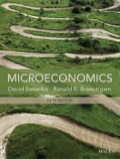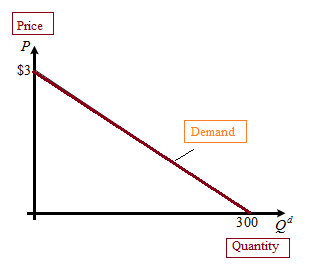
(a)
To fill the given box.
Explanation of Solution
Use the following formula to find the elasticity of
Find the values of Qdby inserting the values in
| P | 0.10 | 0.45 | 0.50 | 0.55 | 2.50 |
| Qd | 290 | 255 | 250 | 245 | 50 |
| eQ,P | −0.035 | −0.176 | −0.2 | −0.225 | −5 |
(b)
To draw the graph for demand function.
Explanation of Solution
To plot the graph just find out inverse demand function.
The inverse demand function,
When price is zero then quantity is:
Similarly, when quantity is zero then price is $3.

The Y axis of graph shows the price and x axis shows the quantity. When price is $3 then quantity demanded is zero. When price is zero then the quantity demanded is 300 units.
(c)
To find the price at which demand is unitary elastic.
Explanation of Solution
Elasticity of demand is equal to:
Let's take the price $1.50, then the elasticity of demand is -1.
Thus, at price $1.50 the demand will be unitary elastic.
(d)
To find the price at which demand is inelastic.
Explanation of Solution
Elasticity of demand is equal to:
Let's take the price $1.50, then the elasticity of demand is -1.
Here, all price below $1.50 will give
(e)
To find the price at which demand is elastic.
Explanation of Solution
Elasticity of demand is equal to:
Let's take the price $1.50, then the elasticity of demand is -1.
Here, all prices above $1.50, will give the demand is elastic.
Want to see more full solutions like this?
Chapter 2 Solutions
EBK MICROECONOMICS
- Using the following equation for the demand for a good or service, calculate the price elasticity of demand (using the point form), cross-price elasticity with good x and income elasticity. Q=82P+0.10I+Px Q is quantity demanded, P is the product price. P1 is the price of a related good, and I is income. Assume that P= $10, I = 100, and Px = 20.arrow_forwardSuppose a movie theater raises the price of popcorn 10 percent, but customers do not buy any less popcorn. What does this tell you about the price elasticity of demand? What will happen to total revenue as a result of the price increase?arrow_forwardWhat is the price elasticity of demand for a vertical demand curve? a. Perfectly inelastic b. Inelastic but not perfectly inelastic c. Unitary elastic d. Elastic but not perfectly elastic e. Perfectly elasticarrow_forward



 Economics: Private and Public Choice (MindTap Cou...EconomicsISBN:9781305506725Author:James D. Gwartney, Richard L. Stroup, Russell S. Sobel, David A. MacphersonPublisher:Cengage Learning
Economics: Private and Public Choice (MindTap Cou...EconomicsISBN:9781305506725Author:James D. Gwartney, Richard L. Stroup, Russell S. Sobel, David A. MacphersonPublisher:Cengage Learning Microeconomics: Private and Public Choice (MindTa...EconomicsISBN:9781305506893Author:James D. Gwartney, Richard L. Stroup, Russell S. Sobel, David A. MacphersonPublisher:Cengage Learning
Microeconomics: Private and Public Choice (MindTa...EconomicsISBN:9781305506893Author:James D. Gwartney, Richard L. Stroup, Russell S. Sobel, David A. MacphersonPublisher:Cengage Learning Microeconomics: Principles & PolicyEconomicsISBN:9781337794992Author:William J. Baumol, Alan S. Blinder, John L. SolowPublisher:Cengage Learning
Microeconomics: Principles & PolicyEconomicsISBN:9781337794992Author:William J. Baumol, Alan S. Blinder, John L. SolowPublisher:Cengage Learning





